Hartford
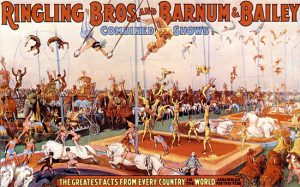 Most people have attended a circus at one time or another, although they are becoming a little more something from the past. Nevertheless, they used to be huge attractions, and when the circus came to town, almost the whole town turned out to watch the show. That was something that worked against the people of Hartford, Connecticut on July 6, 1944. At that time, Hartford was a city of approximately 13,000 people. The Independence Day festivities had just passed and now the circus was in town to continue the week’s excitement for the townspeople. The Ringling Brothers and Barnum Baily Circus was famous for its incredible show, held under a huge circus tent. At 8,000 people in attendance, about 2/3 of the town was there. It was going to be a great show, and the children of the town were beyond excited.
Most people have attended a circus at one time or another, although they are becoming a little more something from the past. Nevertheless, they used to be huge attractions, and when the circus came to town, almost the whole town turned out to watch the show. That was something that worked against the people of Hartford, Connecticut on July 6, 1944. At that time, Hartford was a city of approximately 13,000 people. The Independence Day festivities had just passed and now the circus was in town to continue the week’s excitement for the townspeople. The Ringling Brothers and Barnum Baily Circus was famous for its incredible show, held under a huge circus tent. At 8,000 people in attendance, about 2/3 of the town was there. It was going to be a great show, and the children of the town were beyond excited.
With the tent filled to capacity, a fire is the worst nightmare, but that is what they had. No one knows exactly what happened, and the 8,000 people inside really had no time in which to react. As panic spread as fact as the fire broke out under the big top of circus, killing 167 people and injuring 682. Two thirds of those who perished 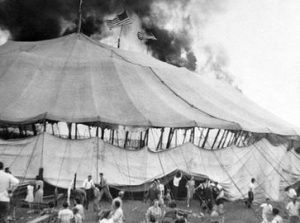 were children. The cause of the fire was unknown, but it spread at incredible speed, racing up the canvas of the circus tent. Suddenly, patches of burning canvas began falling on them from above, and a stampede for the exits began. People became trapped under fallen canvas, but most were able to rip through it and escape, but after the tent’s ropes burned and its poles gave way, the whole burning big top came crashing down, trapping those who remained inside. Within 10 minutes it was over, and some 100 children and 60 of their adult escorts were dead or dying.
were children. The cause of the fire was unknown, but it spread at incredible speed, racing up the canvas of the circus tent. Suddenly, patches of burning canvas began falling on them from above, and a stampede for the exits began. People became trapped under fallen canvas, but most were able to rip through it and escape, but after the tent’s ropes burned and its poles gave way, the whole burning big top came crashing down, trapping those who remained inside. Within 10 minutes it was over, and some 100 children and 60 of their adult escorts were dead or dying.
The fire investigation revealed that the tent had undergone a treatment with flammable paraffin thinned with three parts of gasoline to make it waterproof. These days, no on would consider using gasoline for such a purpose, but unfortunately at that time it was used. Ringling Brothers and Barnum and Bailey Circus eventually agreed to pay $5 million in compensation, and several of the organizers were convicted on manslaughter charges. In 1950, the cause was finally uncovered in the case when Robert D Segee of Circleville, Ohio, confessed to starting the Hartford circus fire. Segee claimed that he had been an arsonist since the age of six and that “an apparition of an Indian on a 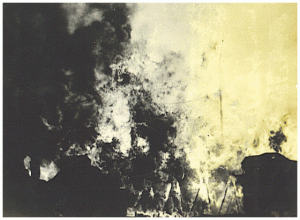 flaming horse often visited him and urged him to set fires.” In November 1950, Segee was convicted in Ohio of unrelated arson charges and sentenced to 44 years of prison time. The Hartford investigators raised doubts over his confession. Segee had a history of mental illness, and it could not be proven he was anywhere within the state of Connecticut when the fire occurred. Connecticut officials were also not allowed to question Segee, even though his alleged crime had occurred in their state. Segee, who died in 1997, denied setting the fire as late as 1994 during an interview. Because of this, many investigators, historians, and victims believe the true arsonist…if it was indeed arson…was never found.
flaming horse often visited him and urged him to set fires.” In November 1950, Segee was convicted in Ohio of unrelated arson charges and sentenced to 44 years of prison time. The Hartford investigators raised doubts over his confession. Segee had a history of mental illness, and it could not be proven he was anywhere within the state of Connecticut when the fire occurred. Connecticut officials were also not allowed to question Segee, even though his alleged crime had occurred in their state. Segee, who died in 1997, denied setting the fire as late as 1994 during an interview. Because of this, many investigators, historians, and victims believe the true arsonist…if it was indeed arson…was never found.
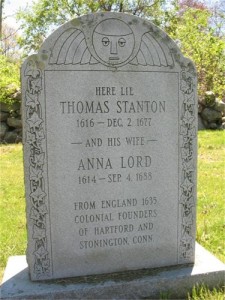 In trying to connect the Stanton side that exists through my dad’s half brother, Norman Willis Spencer, to the Stanton side that exists in Bob’s family through his grandma, Nettie Noyes Knox, I have come up with some interesting information. While I have not made the connection that I’m almost certain exists between the two sides, I did find out that within the Noyes side of the family, there is a Stanton family member who was of some significance to America too. His name was Thomas Stanton, and he was Bob’s 7th great grandfather. There are many ways for a person to have a degree of influence on American history, or history of any nation. Some people become kings or presidents. Others might have been great warriors, while still others might have made some great discovery.
In trying to connect the Stanton side that exists through my dad’s half brother, Norman Willis Spencer, to the Stanton side that exists in Bob’s family through his grandma, Nettie Noyes Knox, I have come up with some interesting information. While I have not made the connection that I’m almost certain exists between the two sides, I did find out that within the Noyes side of the family, there is a Stanton family member who was of some significance to America too. His name was Thomas Stanton, and he was Bob’s 7th great grandfather. There are many ways for a person to have a degree of influence on American history, or history of any nation. Some people become kings or presidents. Others might have been great warriors, while still others might have made some great discovery.
Thomas Stanton was a trader and an accomplished Indian interpreter and negotiator in the colony of Connecticut. He is first noted in historical records as an interpreter for John Winthrop Jr in 1636. He fought in the Pequot War, which took place between 1634 and 1638. He nearly lost his life in the Fairfield Swamp Fight in 1637. In 1638 he was a delegate at the Treaty of Hartford, which ended the war. In 1643, the United Colonies of New England appointed Stanton as Indian Interpreter.
He began a close alliance with the Thomas Lord family, who may have been friends from England and who had recently emigrated from Towcester, England. He married Thomas Lord’s daughter, Anna Lord, about 1636 and went into a merchant business alliance with Richard Lord. Some of Thomas’ land transactions involved serious difficulties, because people often sold and resold land without obtaining a clear title. An Indian sachem gave Quonochontaug to Stanton, but did the chief really own all of this land? A Stanton tract might overlap a tract claimed by another settler. These and other transactions like them, resulted in lengthy and costly litigation. Questions about the ownership of some of Stanton’s land and ambiguities in the will led to years of family and legal fighting.
But, probably the biggest claim to fame that Thomas Stanton had was that he was one of the four founders of Stonington, Connecticut, and one of the first settlers of Hartford, Connecticut. The present territory of Stonington was part of lands that had belonged to the Pequot people, who referred to the areas making up Stonington as Pawcatuck and Mistack. It was named 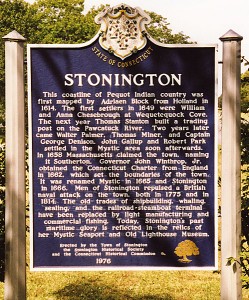 “Souther Towne” or Southerton by Massachusetts in 1658. It became part of Connecticut in 1662 when Connecticut received its royal charter. Southerton was renamed “Mistick” in 1665 and again renamed Stonington in 1666. Thomas Miner, Walter Palmer, William Chesebrough and Thomas Stanton were its four founders.
“Souther Towne” or Southerton by Massachusetts in 1658. It became part of Connecticut in 1662 when Connecticut received its royal charter. Southerton was renamed “Mistick” in 1665 and again renamed Stonington in 1666. Thomas Miner, Walter Palmer, William Chesebrough and Thomas Stanton were its four founders.
Upon Thomas death on Dec 2,1677, his will could not be located, and legal battles concerning the distribution of his property continued for years. When his wife, Anna died 11 years later, his estate was still unsettled. At some point, when going through some papers belonging to the city of Hartford, Connecticut, someone found the will, but that would not bring the estate to the point of being settled. The estate remained unsettled for a total of 40 years before the will was accepted and the estate settled. That is the kind of thing that can happen when money and land are involved.

